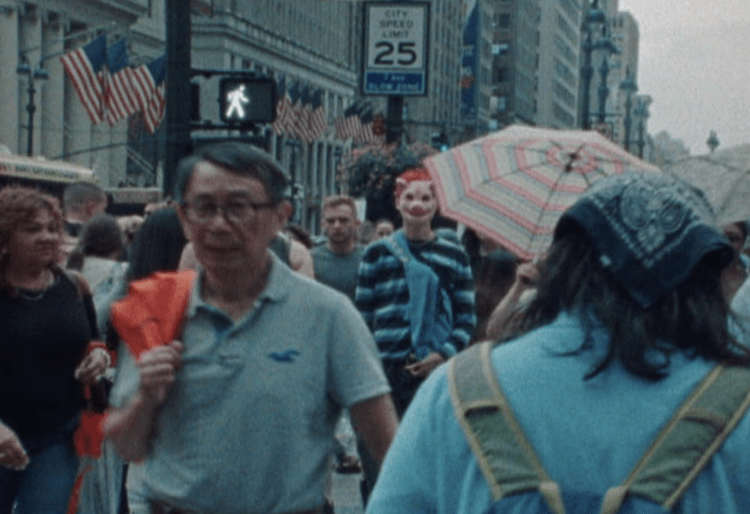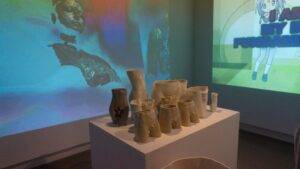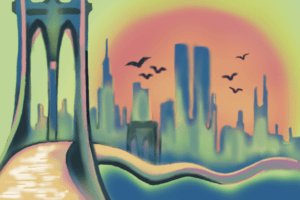
Josh Brainin is an experimental filmmaker and artist based both in Chicago and New York city. He is currently pursuing a MFA at the School of the Art Institute of Chicago and holds a BA from Amherst College. Josh’s body of work explores youth cultures, Black/mixed racializations, masculine conditioning, and the relationship between art and institutional settings.
Watching Brainin’s films, I was in awe of how effectively he explored strange and enigmatic worlds through choreography, intentional costuming, and text and audio. Brainin seamlessly amalgamates elements of theater and experimental film of the likes of Maya Deren or Stan Brakhage, creating a unique style.
Out of all of Brainin’s films that I watched, three of his shorts stood out most — “Cage,” “Shed,” and “Undercover.”
The first film, “Cage,” included a daring public performance taking place on Michigan Avenue. Brainin walked the street in a suit while donning Shibari, a type of Japanese bondage. This footage was intercut with videos of various childhood moments — a live “Indiana Jones” performance at Disney World, young Brainin doing a karate demonstration, and Brainin hitting toys together at a park bench.
The film explores the complex ecosystem of masculinity in our culture and how aggression is socialized into young boys and men. In Brainin’s write up of the film, he describes how “Cage” “utilizes the multiple channels to hone in on the cyclical constriction, disconnection, and grief that comes with wearing the mask of patriarchal masculinity.”
The second film of his I watched was “Shed.” The video installation version of the film was shown at the SAIC gallery’s “In Your Face” Barbara DeGenivive exhibition. “Shed” is a dynamic self-portrait of gender expression and self image composed of images from Brainin’s own iphone library, extracted and printed onto 16mm film and then 35mm film.
The film explores Brainin’s own struggle with self identity and the experience of the hopelessness that comes with failing to meet the male beauty standard. It also documents Branin’s personal experience with hair loss and subsequent hair-transplants by layering a series of selfies with guttural sounds of squishing and surgery, quiet chatter, and the beeping of an operating room. The experience is visceral and sometimes uncomfortable, but it is also raw and emotional as it oscillates between the inner world of the director and an operating table.
The film “Undercover” struck me. At first I believed it to be non-narrative, as there were no representational images on the frames of the hand-processed super 8 film that played onscreen, other than the occasional white outline of a tree or street sign. But after listening more closely to the audio, which layered introspective voice memos over top of each other, it became clear to me that “Undercover” is a coming of age story that is something between, as Brainin describes it, “a repressed confession and youthful gloat.” The film is deeply personal and, following Brainin’s other films, raw and unfiltered.
After viewing his various films, I was lucky enough to interview Branin:
You have so many different elements incorporated into your art; what is your process for planning and executing your films?
Josh Brainin: I’d say my creative process starts with what I’d call an image feeling. I’m a very visual learner. I tend to do better in school if I’m learning visually. My first loves were music and fashion though, and growing up in Chicago, there was a lot of creativity happening within circles of young people. There was the whole Chance the Rapper, Savemoney movement, and so I’m growing up witnessing young people take over the underground and established creative industries in the city.
JB: When some of these guys were juniors in high school, I was in eighth grade, and so there was this whole connection of being able to message these people on Facebook, and I was meeting all these vibrant personalities at the streetwear stores or music festivals, and I was seeing a time where young people’s ideas were running the city.
JB: It felt much more in conversation with like, street style and ways of moving through the world and “swag” and these different ways of carrying and presenting yourself. I think from there I was seeing that “Oh wow, kids and young people can pursue their ideas professionally as teenagers.” So I was like, “what are my abilities naturally?” My taste in music and fashion and interests in personalities and scenes led me to being like, “I should just make films.”
JB: In highschool I became interested in dreams and meditation. That led me to directors like Linklater and David Lynch, who talks a lot about this idea of “catching the big fish,” and the way he uses transcendental meditation to encounter this sort of similar idea of an image feeling in which he then extracts, he writes it down or whatever, and those become scenes. That’s not always my process, but I like to create from this sort of intuitive place as well.
JB: I think my process begins with witnessing an experience that tickles me in some way, which sometimes I may have encountered in a dream, sometimes in a real moment of stress, or sometimes just out in the world wandering. So I’m bringing these things that I have witnessed or experienced, but not always in a literal way.
JB: It’s kind of like I’m sitting there and all of a sudden this gush comes over me, and it may come from inside, it may come from outside, I don’t know fully, but it’ll be like this this world — this scene, that’s already made, appears to me, and then it’s like “Oh I see,” and felt that this person was real, this place was real, the moment made sense emotionally, even if abstract, this feeling was real, and it already felt like it was shot.
JB: I’m reading this book by Alejandro Jodorowsky, it’s about his spiritual journey, and immediately he’s very unabashful on how he speaks of the validity of encountering ideas and sights that are not spurred solely through intellect or rationale. I’m inspired by some artists who are not just approaching this as a business, but who take their pursuit of the absurd or surreal with a lot of focus and detail.
JB: Other projects of mine like “Undercover” and “Shed” were more about letting my anxieties and confusions be processed in the open. I was thinking about undoing certain ideas of masculine conditioning, which for me were these ideas of stoicism as strength, “don’t feel,” you know, don’t share your feelings openly. And so those pieces for me are looking to be like glitches, wrenches in the cog in regard to the social norms aligned with masculine conditioning. It’s the thing I’m not supposed to do. It’s like, “Oh yeah, you lost your hair or whatever. Move on, who cares?”
JB: But it’s like, for a long period of time, I looked at myself in the mirror in agony and it’s self-absorbed, but it’s also like a sense of a loss of self. Talking about it openly in my piece, “Shed,” has helped me connect and talk more openly about it with others, which has helped me feel less shame.
JB: The project “Undercover” is about this hidden intimate teenage experience, and never being able to talk about that and realizing as an adult that I’m still processing the experience unknowingly. So in that way, I guess my inspiration for these pieces was like looking to these moments, where there may be an experience buried or stuck in me, and once I feel the fear that “I’m not supposed to say this,” I then become curious around what I’m trying to conceal and what that serves.
JB: It’s like, what if I cut and dissect my facade and open the inside to the outside, so they can merge, to let some of these more internal emotional self reflections connect outside to the world that also informs them? So in that sense, those projects are a bit healing for me, it’s more like doing a journal entry with videos, and allowing it to be in connection with others and not keeping it as a hidden thing that I’m ashamed about.
JB: As a queer person growing up, I at times saw images of other artists, or other musicians expressing themselves freely, and I found those moments to be really cathartic and healing, and resonating in the sense like, “Oh, I’m not crazy. I’m not alone.” And those have been like safe havens for me, those images, those songs, those figures.
JB: And I’m not saying they’re perfect people. For instance, Frank Ocean was one of my first influences at 12, as being someone who’s also black and kind of — I don’t even use the word, I use the word queer now, but at the time I was using the word bisexual. Anyways, it was just like “Oh wow, I can embody myself, I can embrace myself, I can be safe here,” and so I’m looking to do some of that when I’m making these pieces, in ways that challenge my vulnerability, yet also allow me to be in integrity and ethical.
KM: Your films have such a distinct style that comes through in all your pieces. What are some influences, such as other films, writers or artists that have affected your artmaking?
JB: I feel like it’s like a whole amalgamation of stuff now. For some reason, I can’t let go of my adolescent and teenage years, especially between 12 to 16, I don’t know why.
JB: Growing up, being in sixth grade, I got into art pretty young, and in Chicago, through the clothing boutiques and concert venues, there are all these things that allow making art to happen, and I feel like recently the more I’ve been making, the more I find that I want to go back to that first feeling of being 12, and that first time I was like “Oh wow.”
JB: I was really inspired by Odd Future. I’m really interested in them since they didn’t fit neatly into a box, and I’ve always just been into other people that can make me feel seen and accepted in my body in that way. I think Odd Future being these black youth, like really weird, but an unapologetically expressive, artistic collective really inspired me. I think that gave me more confidence right away to explore the abstract and the way it can be emotionally impactful.
JB: I went to Pitchfork and saw them at 12 and it was crazy. That was a pretty raw energy to witness. They were very controversial. It’s not the same Tyler the Creator who is now like, post-“Flower Boy.” It was one who was saying way more questionable shit. And maybe that was honestly coming from a place of him being repressed.
JB: But yeah, I have to cite early Odd Future as an early inspiration. I think the fact that they were doing all their videos, fashion, and music really resonated for me. I’m someone who enjoys film because of the merging of art forms that it provides.
JB: Growing up, I also watched a lot of anime, and it inspired this idea of humans, or humanoid beings, in these exaggerated outfits and having these metaphysical abilities, and I think that made me feel it was real. And so I think I continued to move in life with this kind of idea that people have energies or powers or things like that, and that they reflect these unseen abilities through the way they dress and accessorize. That’s something I like to still feel when I’m making art.
JB: I use the word humanoid because I like to give my characters — “Eyes Closed See Stars” is an example — spaces where they’re dressed and doing behavior that’s kind of outside of the standard social norms of the site, and the way that provokes the question of if my characters are human or not. Japanese, specifically cyberpunk films, have been an inspiration. Soviet films too.
JB: Over the past couple years, I’ve been very interested in independent Black filmmakers. It’s crazy to me that a lot of these films are just recently getting the recognition they deserve. Several of the primary films that have been influential to me are stories by Black female directors that have been restored recently. Maya Cade, Milestone Films, and the Black Film Archive have been doing amazing work. One showed at the Gene Siskel earlier this year was called “Naked Acts” and I would say those sorts of films like by Cauleen Smith, Cheryl Dunye, Kathleen Collins, and Bridgette Davis are all indie filmmakers, whose older work I am more recently becoming exposed to and inspired by.
KM: What is your favorite part about making films?
JB: I don’t know. It makes me feel the best. Like, making art makes me feel, honestly, really good. A lot of my teens and early adult life has been about, kind of, stabilizing my mental and emotional well-being, so I’d say that art and film have always been helpful tools.
JB: I would say my biggest thing in the past few years has been really taking the time to try to work on myself as a person and not just as an artist. I don’t know what my favorite part is. I think I’ve always loved making things, I feel it and I see it when I close my eyes or space out on the train and it feels like it’s already a moment or a scene sliced out of an already formed world.
JB: The route I was on before was like “Fuck it, like I’ll do my thing, I’ll blow up, I’ll be this dope director.” I was like 22 or whatever, and I don’t want to work through that model anymore, of thinking I know it all. I want to make stuff with friends, in community, not just in my own isolated vision.
JB: Some of the work over the past few years I have done has been to work in community to unlearn patriarchal ideologies, informed by the text of Black feminist writing, specifically Bell Hooks. She has this book “The Will to Change: Men, Masculinity, and Love” and it’s been impactful for me.
JB: There’s a great documentary called “Feminist Cell Block Y” by Contessa Gayles, that expands on these ideas and ended up becoming the initial men’s group I joined when they initiated a Chicago sector.
JB: Art and film have been a way for me to share the way I feel and see. I think it feels so affirming to be able to share that and witness it be received.
KM: All of your films are deeply personal, what part of your personal background and life experiences would you say have affected your practice the most?
JB: I would come back again to witnessing the limits of my perceptions, ideologies no longer serving me, as the place where I began my current art career, starting at like twenty three, I’m twenty seven now. I took a two-year break from making film and just drew. I was working on children’s books because I was honestly going through a lot of emotions and drawing made me feel good.
JB: Masculinity informed through patriarchy is a set of ideologies I find myself grappling with and consistently untangling. I make these personal pieces processing through masculine conditioning and it’s important to me that these conversations occur in a communal space.
JB: Through making these pieces and having vulnerable conversations with other AMAB people, I’ve found there to be a lot of overlap in the way that the conditioning did not support a version of who they aspired to be too. So for me, speaking openly in these films, is like putting a chip in the armor of the facade of like “alpha male” toxic masculinity, or at least that’s what my aim is to do.
JB: So I’d say, this experience in my mid 20’s, of beginning to engage with my men’s group, my therapist at the time, and a lot of emotional plus physical support from my loved ones are the core foundation for my new work.
If you are interested in seeing some of Josh Brainin’s work you can explore it for yourself on his website.







